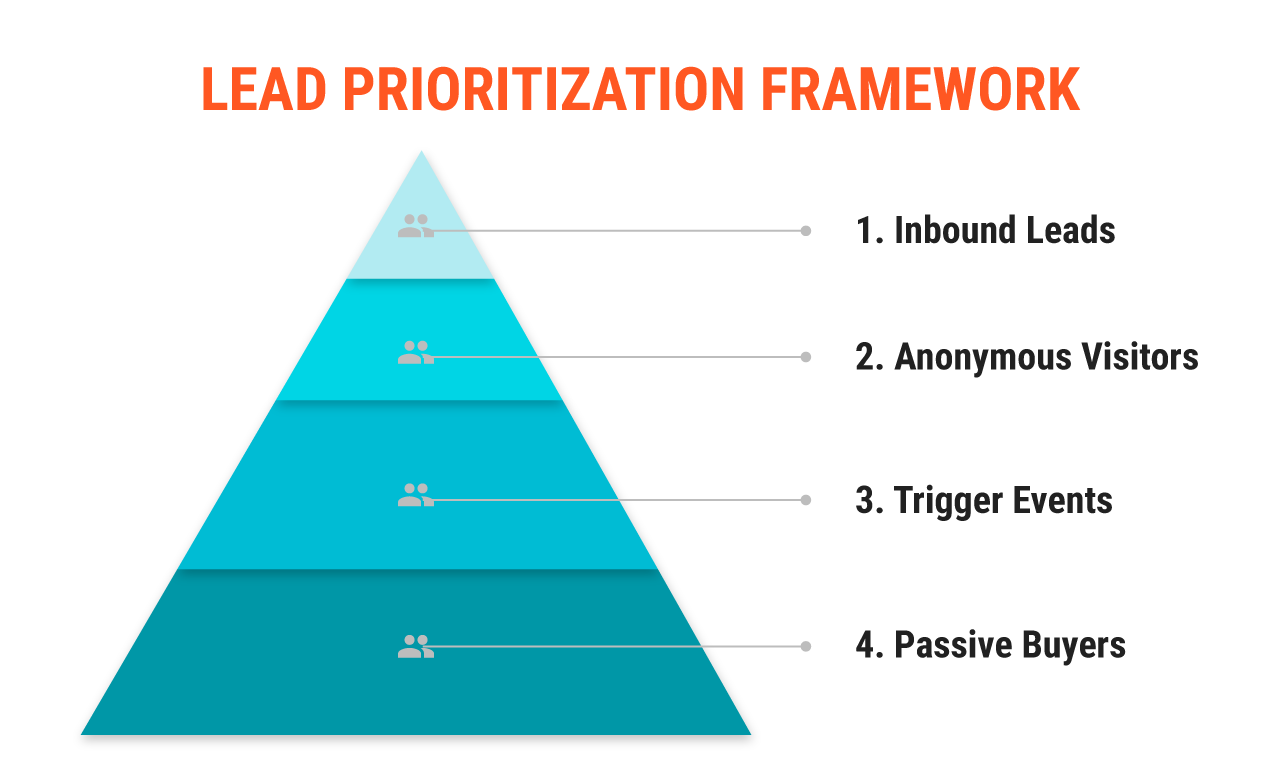
Written By:
Sean Henri
Knowing which leads to focus on first can be the difference between your business succeeding and failing. If you waste too much time focusing on leads who aren’t a good fit for your business or who will never buy from you, you can easily let high quality leads slip through the cracks and go to a competitor while they wait for your response.
Successful salespeople prioritize their time wisely and focus on the leads that have the best odds of closing. Rather than working through a list in alphabetical order, company size, or some other legacy approach, they listen to the market to identify the buyers that are active in a buying journey.
Know which buyers you can help, and which you can’t
Creating buyer profiles is an essential first step before creating any prioritization framework. Not to be confused with buyer personas, buyer profiles are descriptions of the types of companies that are a good fit for your business, and those that are not. These profiles can include things like industry, annual revenue, number of employees, whether they are B2B or B2C, their operating structure, or the type of equipment or software they utilize.
By contrast, buyer personas talk about the common characteristics of individuals within these types of companies, and tend to be more focused on their research process and their buying behavior rather than their company’s firmographics.
Free eBook: The Definitive Guide to Selling Better and Faster
Develop a Lead Prioritization Framework
Once you’ve defined your ideal buyer profiles, and have a solid understanding of the types of businesses you should be spending time on, you can begin to prioritize contacts within those companies to engage with. Below is a recommended framework to utilize to increase your odds of success.

1) Start with active buyers.
Smart salespeople know that starting with an active buyer will typically produce better results than someone who is not in an active buying process. Fortunately, with the flood of information available to us online, combined with modern sales technology like customer relationship management (CRM) software, you can help you distinguish those who are in an active buying state from those who are not. Common sources of active buying signals include:
- Inbound leads
- Anonymous companies browsing your website
- Trigger events
Inbound leads are undoubtedly going to be your highest quality lead, as these leads have explicitly asked to be contacted. To ensure a timely follow-up, be sure to configure your website to send leads directly to your CRM in real-time. Seconds matter here, so you want to build a process that is as efficient as possible. According to InsideSales.com, the odds of contacting a lead if called in 5 minutes versus 30 minutes drop 100 times.
Your CRM should be configured in a way that displays your inbound leads first, so that each salesperson can start their day enriching and attempting to qualify those leads. Having your buyer profiles defined and easily accessible will help streamline this process. Sorting this list by lead score can help you start with the cream of the crop.
2) Identify anonymous companies viewing your content.
According to a 2015 research study by Forrester, 59% of buyers preferred to do their own research online and not interact with a sales representative. Nearly all buyers will do some research online. If your website has been optimized for search engines and contains content that facilitates the buyer’s journey, there’s a very strong chance you’re doing that research on your website, too.
Yet with even best-in-class websites only converting around 5% of all visitors, what about the other 95%? Wouldn’t it be nice to know who they are?
Modern CRMs will provide you with a tracking script that uses reverse IP lookup technology to identify the company names of those prospects who are anonymously browsing your website.
After exhausting the list of inbound leads who have self identified, savvy salespeople will turn to this list of anonymous prospects who are in an active buying cycle, and look for ways to open the conversation. By reviewing the data in your CRM or marketing software, you should be able to determine:
- Which blog posts they read
- Which product or services pages they viewed
- If they viewed your pricing page—a red hot signal that they are thinking of buying
If the company is engaged and matches your buyer profile, a quick online search on Google or LinkedIn will typically help you uncover the right contacts to reach out to. Armed with the context of their visit, you can open the conversation in a helpful, informed way.
3) Look for trigger events.
A client of mine who’s been in sales his entire career once told me about an industry association that had a room of newspaper clippings containing all of the latest industry news—new hires, expansions, mergers, etc. In order to stay tuned in to changes within his territory, he would have to physically drive to this building at least once a month and then spend hours reading through paper.
Fifteen to twenty years ago, this time-consuming activity was a necessity if he wanted to stay in tune with the type of trigger events that might open up an opportunity. Thanks to modern technology, identifying these types of trigger events has become much easier.
Common trigger events that might indicate a prospect is either in, or will soon be in an active buying cycle include:
- New executive hires, or significant role changes
- Press release announcing funding or a new facility
- Social media post by a potential buyer related to your company’s value proposition
- A mention of a competitor on social media
- A cold lead revisits your website after months of inactivity
Social networks are one of the best sources for uncovering these types of trigger events, and Social Selling tactics are a great way to uncover them. To get started, begin following your prospects, customers and industry influencers who might clue you in to these events. Create Twitter Lists, Google Alerts, and other ways to search for and monitor words or phrases that might help you uncover a trigger event.
Once you’ve uncovered an event, add the person as a contact in your CRM, and begin logging your outreach efforts for a full history of the conversation.
4) Move on to passive buyers.
If you’ve exhausted your Inbound Leads, anonymous browsers and contacts with trigger events and still haven’t hit your sales goals, you can begin looking at passive buyers. These should be a last resort however, as these prospects are the least likely to buy in the short term, and may not be open to engaging in a conversation with you.
If targeting passive buyers, remember that they have done nothing to indicate that they have any interest or need in your product or solution. You might be best served to aim to develop a friendly relationship rather than push them into a sales process, as that relationship can give you a competitive advantage down the road when their company moves into an active buying state.
Alternatively, they might have friends or former colleagues at other companies who they could refer business to you. Even if they never become a customer, they could become a valuable source of referrals.
If you’ve made it to this level on your list, your time might be better served resorting to inbound marketing strategies. Rather than cold calling a list of prospects who have had zero previous interaction with your company, spend a few hours writing a helpful blog post that might appeal to the prospects and pull them to your company website.
Enrich leads and connect
Regardless of which tier of the Lead Prioritization Framework you begin with, the next step in your process should always be to enrich the data in your CRM before initiating a contact attempt.
Even a detailed inbound lead may not reveal everything that you would want to know prior to picking up the phone and contacting a prospect. Start by reviewing their contact record in your CRM and ensuring that all important data such as name, company, job title and contact information is complete and formatted correctly.
Follow this step by visiting their company website, looking at recent social postings, and reviewing their recent press releases and blog posts to get a feel for what might be top of mind once you get the prospect on the phone.
With an active buyer and a mountain of information at your fingertips, it’s time to connect. Now go get em’!







